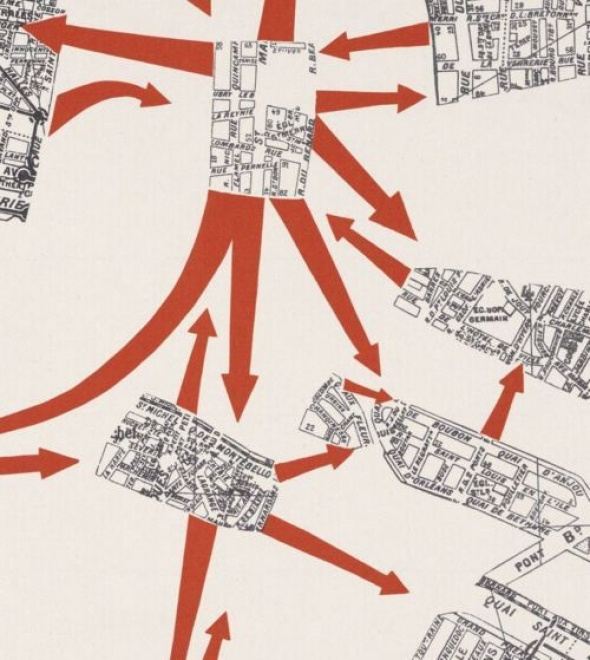The Situationist City
Benedict Seymour reviews Simon Sadler's introduction to Situationist (critique of) urbanism
Faced with this scrupulous academic history of Situationist architectural theory, hardline pro-Situationists will no doubt suspect a truncated account of the Situationist project. Sadler anticipates these accusations, acknowledging that his narrow focus on the urban theory produced in the inital phase of their activity necessarily isolates Situationist ideas about the modern city from a much broader revolutionary program (they were, after all, taking on 'the ideological totality of the Western world', not just building Domes or diverting traffic). Nonetheless, he succeeds in clarifying key ideas by 're-zoning' the Situationists into the territory of post-war mainstream and experimental architectural debates, working outwards to hint at the broader implications of the Situationists' 'unitary urbanism'.
Situationist architectural thinking emphasised flexibility, freedom and play. Sadler locates it in the context of competing post-war attempts to fashion an alternative to the dehumanising functionalist rationality of high Le Corbusierian modernism, showing how the Situs' critique and re-imagining of the city went beyond architecture to call for a global transformation of social reality. This extremism was unsurprisingly absent from the theories and designs of other leisure-fixated contemporaries such as London's Independent Group, Archigram, and erstwhile radicals like the now thoroughly Blair-compatible Richard Rogers. Indeed, Rogers, who once shared the Situationists' enthusiasm for technologically-facilitated social liberation, ironically went on to build the Pompidou Centre, a cultural behemoth planted on top of the Situationists' favourite quarter of Paris.
Unfortunately, the Situationists themselves couldn't seem to agree on what form Situationist architecture should take. The theorist Guy Debord, who preferred grand, fragmentary, unachieved visions (Paris reconsidered as a pinball machine, for example) inevitably came into conflict with Constant, a trained architect and one of the more practically-minded members of the Situationist International. A proponent of the 'megastructure', Constant created fabulous models and photocollages of his beautiful and influential project for a Situationist city, New Babylon, trying - more than his colleagues - to extrapolate architecturally from the Situationist principles of drift, 'detournement' and endless play. For this, however, he was branded an architectural 'reformist' and eventually expelled from the S.I.'s ranks. As the S.I. grew older and hopes of immediately realising the Situationist 'situation' diminished, the remaining members preferred to limit themselves to a critique of actual social space.
Sadler's book is most interesting when it traces the absorption of Situationist ideas into mainstream postmodernist architecture and culture. Examples include the rise of the theme park and the shopping mall, caricatures of the 'total space' the Situs envisaged. Constant's dynamic, labyrinthine city-network even resembles the imaginings of contemporary cyber-visionaries. But here, too, Sadler detects an impoverishment of Situationist aspiration. For him, internet architecture represents a retreat from the real into virtual space. (One could add to this list of degradations the increasingly banalised notion of 'interactivity' that has succeeded the Situationists' own cherished conception of active aesthetic and social participation.) This fascinating book makes you wonder if we got what the Situationists thought they wanted - or whether, as Pro-Situ apologists might claim, we inherited a mutilated version of their dreams.
The Situationist City, by Simon Sadler, published by MIT in February 1998.
Mute Books Orders
For Mute Books distribution contact Anagram Books
contact@anagrambooks.com
For online purchases visit anagrambooks.com








